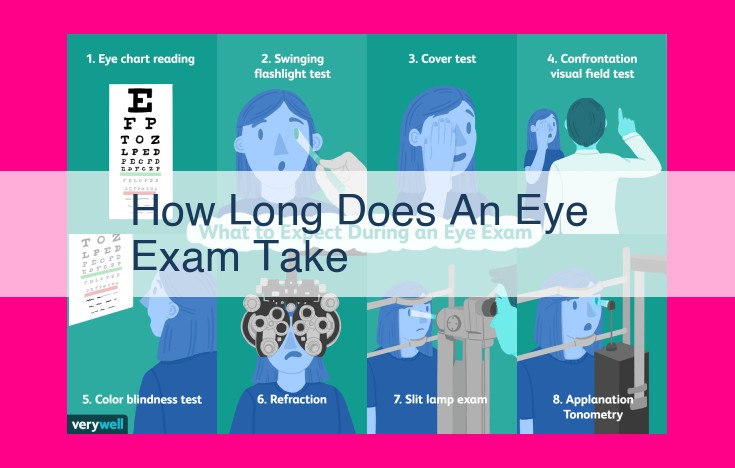Eye Exam Duration: Factors Affecting Length And Equipment Used

The duration of an eye exam varies based on individual factors, such as age, visual acuity, and eye health history. A comprehensive eye exam, which is typically more thorough and recommended annually, can take approximately one to two hours. It includes tests such as visual acuity assessment, pupil dilation for retinal examination, and visual field analysis. Age-related factors, like presbyopia, and ocular conditions, such as cataracts or glaucoma, may influence the exam’s length and the equipment used, such as autorefractors or fundus cameras, to diagnose and monitor specific eye conditions.
Patient Factors Influencing Eye Exam
- Discuss how age, visual acuity, and ocular health history impact the type of eye exam recommended.
Eye Exams: Tailored to Your Unique Needs
Navigating the world of eye exams can be daunting, but understanding how patient factors influence the type of exam recommended is crucial for optimal eye health.
Age: As we age, our eyes undergo natural changes. Children’s eyes are particularly dynamic, requiring regular exams to monitor their visual development. Older adults are more susceptible to age-related eye conditions, necessitating more frequent and comprehensive exams.
Visual Acuity: Your visual acuity measures how clearly you see objects at different distances. Individuals with 20/20 vision typically have normal eyesight, while those with nearsightedness (myopia) or farsightedness (hyperopia) may require corrective lenses. These factors determine the specific tests and measurements included in your eye exam.
Ocular Health History: Your ocular health history plays a significant role in tailoring your eye exam. If you have a family history of eye conditions, such as glaucoma or macular degeneration, your doctor may recommend specialized screenings. Current eye problems or previous surgeries will also influence the type of exam required.
By considering these factors, your eye doctor can customize an eye exam that addresses your specific needs, ensuring the detection and management of any potential eye conditions.
Exam Types: Comprehensive Eye Exam
When it comes to maintaining optimal eye health, regular eye exams are crucial. The most comprehensive option is a comprehensive eye exam, a multifaceted assessment that provides an in-depth picture of your eye’s health and function.
Purpose and Components
A comprehensive eye exam is designed to assess the overall health of your eyes, detect any abnormalities or underlying eye conditions, and determine the need for corrective lenses or treatment. It typically includes the following components:
- Visual acuity test: Measures your ability to see clearly at different distances.
- Refraction test: Determines the prescription for corrective lenses (eyeglasses or contact lenses), if necessary.
- Ocular motility exam: Evaluates how well your eyes move and coordinate.
- Eyelid and external exam: Inspects your eyelids, eyelashes, and the surrounding area for any abnormalities.
- Pupillary exam: Checks the response of your pupils to light.
- Slit-lamp exam: Uses a specialized microscope to examine the structures of your eyes, including the cornea, iris, lens, and vitreous humor.
- Dilated fundus exam: Involves dilating your pupils to allow a detailed examination of the back of your eyes (retina, optic nerve, and blood vessels).
Thoroughness and Frequency
Comprehensive eye exams are the most thorough and provide the most detailed information about your eye health. The frequency of these exams varies depending on your age, risk factors, and overall health. Generally, it is recommended to have a comprehensive eye exam every one to two years for adults and more frequently for individuals with certain medical conditions or who wear corrective lenses.
Regular comprehensive eye exams are critical for early detection and management of eye conditions, such as glaucoma, macular degeneration, and diabetic retinopathy. By identifying potential issues early on, your eye doctor can recommend appropriate treatment options and help you maintain healthy vision for life.
Equipment Utilized in Eye Exams: A Comprehensive Guide
In the realm of eye care, specialized equipment plays a pivotal role in ensuring precise diagnoses and effective monitoring of various eye conditions. These tools empower eye doctors to delve into the intricate details of your vision, unveil hidden ocular issues, and safeguard the health of your precious eyes.
Autorefractors: Unveiling Your Vision’s Secrets
Like a wizard’s wand,autorefractors send out gentle beams of light, instantaneously determining your exact prescription. They meticulously measure the shape of your cornea, revealing the precise refractive errors that may be impairing your vision.
Dilating Drops: Windows to the Soul
Dilating drops, the key to unlocking the secrets of your eyes, work their magic by widening your pupils, offering an unobstructed view of your retina, the intricate tapestry at the back of your eye. This expanded canvas allows your eye doctor to meticulously examine the delicate structures within, detecting any signs of disease or damage.
Fundus Cameras: Capturing the Essence of Your Retina
Fundus cameras, like artistic photographers, immortalize the beauty and complexity of your retina. These cameras capture high-resolution images, revealing a detailed map of your optic nerve, blood vessels, and macula, the central point of your vision. With these images, your eye doctor can detect minute changes and monitor the progression of eye conditions over time.
Visual Field Analyzers: Mapping the Horizons of Your Vision
Visual field analyzers, the guardians of your peripheral vision, measure the extent of your visual field, uncovering any blind spots or areas of impaired sight. They detect subtle changes that may indicate conditions such as glaucoma or macular degeneration, allowing for early intervention and preservation of your precious vision.
In conclusion, these advanced eye exam tools empower your eye doctor to illuminate the depths of your eyes, unveiling hidden conditions and safeguarding your vision. By embracing these technological marvels, you can ensure the continued health and well-being of your most valuable asset—your sight.